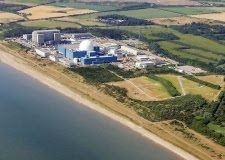 Photo Sizewell. UK.
Photo Sizewell. UK.Following the disaster of tsunami at Fukushima where back up electric power failed (required to pump water for cooling) and with it the capacity to cool down the plant one cannot fail to see here another nuclear plant so close to water and yet so far. Should one have different designs with back ups less dependent on batteries?
Nuclear whistleblowers in USA did point to various dangers of this reactor many years ago.
How elastic should the structures be to enable it to withstand the earthquakes? The horrific pictures of exposed nuclear rods is almost too much to bear. Alternatively, should some structures be burred? Engineers are the ones who can answer these questions and weigh the risks.
All nuclear plants must be reviewed now for safety threats due to natural disasters in order to improve current and future plant designs. Earthquakes will happen again. They may happen in areas considered safer than Japan. The world is hungry for power but not good at fortune telling.
Widespread distrust of officialdom has led to panic buying in many countries of things like potassium iodide salt tablets in hope to absorb the radiation if it spreads to the rest of the world.
Nuclear whistleblowers are from different professions: some are scientists but not all. Mr Latif Amin, British nuclear whistleblower was a customs official who was sacked for talking to journalists about nuclear smuggling.
WikiLeaks report on whistleblowers from General Electric about the lack of safety at Fukushima to Japanese Governement is here. There was a cover up and falsification of records by Japanese and some GE worker as well.
Japanese Whistleblower Act came late.
The culture of corporate loyalty has much to offer as I know only too well from my own working for a Japanese company when I was a medical student. However, whistleblowing although it may seem paradoxical is an act of loyalty. People who do not care do not bother to criticize or expose the failures.






2 comments:
Fukushima Daiichi is the oldest 'boiling water' reactor set in Japan and is long past it's 'sell by date', with reactor 1 some 40 years old. Plants generally have 30 years of life, but can be relicensed for further use provided there has been no deterioration of the structure.
How anyone would build such a plant so close to the fault line boggles the mind. Especially one that uses 'mox' fuel rods, which combines both plutonium and spent uranium as it's energy source. The proximity to the sea has always been both a blessing and a danger. You need seawater for some of the cooling, and as a ready backup for flooding if all else fails, that is why every UK plant is by the sea, except for one, which is by a lake. But this, in an earthquake zone posits the problem, all too well demonstrated in Japan of inundation in a Tsunami.
Japans dependence on Nuclear Power is in part due to it's dearth of resources, and it's close links with the US post war, who sold them this design, as they did to us at Sizewell (the later pressurised water design). They have 55 plants currently, many of which are scattered along this same shore as Fukushima, which will never function again I'm sure.
I have worked in this industry, designed ALARP protocols, but I have to say I have always done it from the view of a sceptic, and the best person to help govern safety is one who is convinced that disaster waits around the corner.
When I hear that potassium iodate has already been administered, then the end game is in site. Ground level readings of in excess of 400 miliseverts per hour have been registered, which only adds to my feeling of dread. What is unknown, or rather not revealed is the type of emmissions or contamination type which has a huge bearing on outcomes both for the people and the planet. But the secrecy that has prevailed in the industry, the levels of security funded by the taxpayer in the UK, for that which is now a private company (EDF Energy) makes me think we will continue to remain so.
This country is set on a course to increase or at least replace it's current ageing reactors. All except one Magnox plant has closed and the AGR's are on borrowed time. So we are to build some new one's, on existing sites, of a new and as yet unproven type. I hope that this terrible but avoidable chain of events may make us think again.
Thank you, Blackdog for your generous comments.
If scientists had all the resources they may need what would they build?
Post a Comment